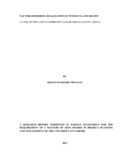| dc.description.abstract | The study was aimed at establishing factors that continue to hinder the realization of women
land rights even with existing clear Constitutional provisions that give men and women equal
rights to own and inherit land. The study as based, in Kakamega, Western Province of Kenya.
Chapter one introduces the objectives of the study and justifies the need for this study among.
The central focus of the literature review is what other authors have documented as factors
that continue to hinder women from realizing their land rights, draft bills that touch on women
and Constitutional provisions on Women land rights. The study presents some of the factors
which inhibit or act as constraints to acquisition and ownership of property by women. Of
special significance to the study is the position of women with regard to marriage and
inheritance, awareness levels among women on land rights, existing cultures, socio-economic
effects of women land rights and how these affect the management of resources at the
community level. The analysis stresses that lack of property ownership by women is a socioeconomic
hindrance to their involvement in their own development and that of the nation. A
historical background 'is presented, indicating property ownership patterns in Africa during
the pre-colonial and post independence periods. A review of literature on women in relation to
the acquisition of property indicates the challenges that influence ownership of land to women
in Kenya. Qualitative research methodology is what the study applied to collect and analyse
data to understand in-depth the research objectives which include the awareness levels among
women on land rights, gaps in civil society organizations, impact of culture and the socioeconomic
impacts of culture on women land rights. From the study, women land rights as
viewed by the community is largely unacceptable (49%) with many associating it with a taboo
(21.6%).This represents more than half the population under study Very few people (11.8%)
within the community accept that women have equal rights to own and inherit land. majority
of male students enrolled in early childhood education. Cultural practices, low income and
low awareness levels were some of the factors indentifies by this study as hindering women’s
right to own and inherit land. (41.2, 25.5 and 2.0% respectively).The researcher
recommendations to donors and development partners is invest more on women land rights,
increase support for free litigation and increase public awareness on Women land rights. The
reasearcher further recommends the introduction of women land rights in the syllabus | en |

